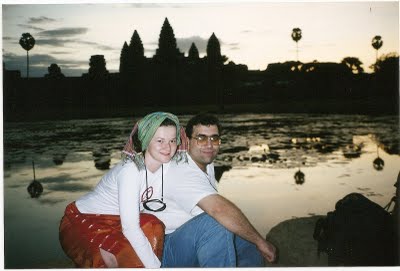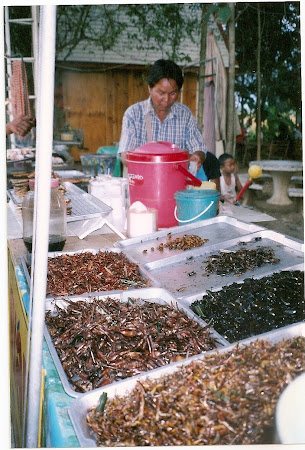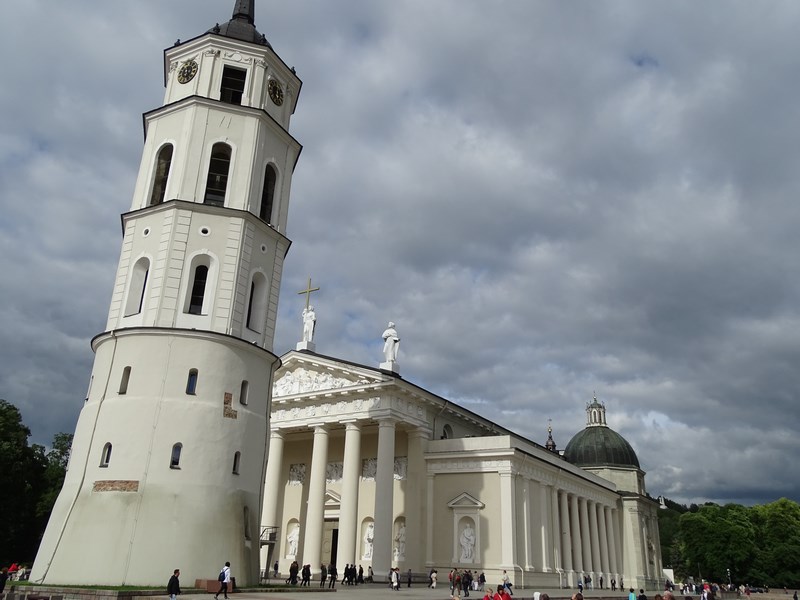Angkor Wat – the jewel in the Cambodian jungle
Somewhere, far away, in the middle of Indochina, there lies one of the most remarkable architectural treasures of mankind. Perhaps the largest religious complex in the world, Angkor Thom brings together more than a hundred temples in the Cambodian jungle, among which the most important is the one who gave its name to the entire complex – Angkor Wat.
The Angkor complex is located in the kingdom of Cambodia, a country in the middle of the Indochinese peninsula, known more by the genocide practised by the Khmer Rouge regime that, in the ’70s, decimated the population of in Cambodia by almost a quarter and threw a black spot on this beautiful, but terribly poor country. The complex is near the little town ofSiem Reap, a nice town, perhaps the most developed city inCambodia, due to the fact that more than one million visitors visit Angkor Wat each year. Siem Reap has an international airport, connected with several Asian cities (Bangkok, Singapore, Hanoi, Seoul, Kuala Lumpur, Hong Kong), but the most important route is the one in Bangkok which brings many tourists from Thailand, the Mecca of the South-Asian tourism, daily. The road connections with Thailand has been significantly improved in the last few years, so now it is pretty easy to reach Siem Reap and discover the Cambodian jewel.
Spread over a huge area, Angkor was the capital of the Khmer empire, one of the most developed and largest states since the beginning of the last millennium. Yet, the Cambodian state dates back since about the time of Christ, the local culture being strongly influenced by the Indian religion and culture – the first kings in the area were the Indian Brahmins who brought along Hinduism and Buddhism, nowadays most of the people being Buddhists. To visit theAngkorcomplex, it is compulsory to have a means of transport – you can rent anything from bicycle and motorcycle to limousine, but except the bike, you must also “rent” the driver… and, for a fun experience, the best is the tuk-tuk.
In the complex, there are two types of temples – Hindu temples – temples of the mountain type, which evokes Mount Meru, the sacred mountain of the Hindu, the dwelling place of the gods and Buddhist temples – the gallery type, passing through a series of rooms. However, no temple looks like the other, so, although you can visit up to a dozen, you always find something new. Some temples have not been restored yet, so you can bounce among huge trees that embrace and, in some cases, support the buildings which otherwise would collapse. It is not good to go immediately to the great temples Bayon and Angkor Wat to benefit from a crescendo of beauty, but try, at first, to find smaller temples – “small” is a way of putting it…
Near every temple, the Khmer children storm the cars or the tuk-tuks with tourists to sell souvenirs to them… in fact, it is here that I heard the best reason to buy something from throughoutAsia- “if you do not buy, I cry.” And the most popular souvenirs are T-shirts with Angkor Wat, which read “Attention! Land Mines,” pursed hats of the Vietnamese type or Khmer silk shirts. The entrances to Angkor Thom are guarded by gates adorned with figures of warriors or kings. From time to time, curious monkeys jump in front of cars in search of food, and, if you want to walk a bit with the elephant, you can just as well do that, too, as the gentle giant will carry you to a hilltop, from where you can admire a rather average sunset.
However, let us return … the youngest temple in the complex is the gigantic Bayon, a mountain-temple built by King Jayavarman VII in the 13th century. Its key feature is represented by the tens, maybe hundreds of portrayals of a human figure, most probably King Jayavarman the VIIth himself, most of the times smiling, sometimes mischievously, at other times amused, only once being serious, though. At the foundation of the temple there are various reliefs depicting activities of everyday living (scenes of war, but also commerce, such as weighing fish in the market), which, together with a detailed report of the Chinese ambassador to Angkor in 1296, depicts life in enough detail in the royal city.
Another famous place is the Ta Phrom temple, where the gigantic jungle trees embrace the buildings, supporting them not to fall and climb the temples, creating a fascinating show of the winner nature. Moreover,Hollywoodmade him famous, because Angelina Jolie shot the film “Tomb Rider” here before adopting a Cambodian child.
But, the main temple, the undeniable symbol ofCambodia(a stylized representation of which can even be found on the national flag) is the beautiful Angkor Wat temple. Basically, for every visitor, the impact of Angkor Wat is overwhelming. You can but sit, tell yourself you cannot believe what you see so that, later, you should enjoy the most fascinating temple built by people for their gods. Built by King Suryavarman II in the early twelfth century, Angkor Wat is, according to Guinness Book, the largest religious building in the world. Of all the temples inAngkor, it is the only temple that was used as a permanent place of pilgrimage, even after the Khmer Empire was destroyed by the Thai attacks and other temples were swallowed by the jungle. Angkor Wat was “discovered” for the Western culture by the French colonists in the nineteenth century, who have, actually, started the restoration in the twentieth century. Angkor Wat is a temple mountain, built on several floors, but only the clergy are allowed to climb to the upper floors, and only the King on top, in order to be able to quietly discuss with his kin gods. The walls display incredible stuccos walls that portray thousands of apsaras, celestial dancers whose delicate dance performances can be admired at the shows in Siem Reap. For an unforgettable memory, it is, however, worth to wake up at the crack of dawn to experience the sunrise at Angkor Wat, with the temple towers appearing as if by magic out of the darkness of the night – especially if you enjoy a moonless night.
And if you get tired by the days spent at the temples, you can always change the landscape, sitting quietly in a tuk-tuk, chilled by the wind, and visit the countryside near Siem Reap, a green empire with rice fields and houses suspended on wooden stilts to avoid the usual flooding in the rainy season, take a visit to a silkworm farm where you will be explained that the Cambodian silk is far better than the Thai one, you can visit some of the world’s poorest people , the Vietnamese who live their life on the water, on the boats on Lake Tonle Sap or be horrified when visiting Pol Pot’s death centers.
Although it has an aura of mystery and danger, Cambodians a stable, peaceful with welcoming people who smile from ear to ear. And if you happen to spend your holiday in Thailand, you have to break a few days to visit the most beautiful place in Indochina … Angkor!
How to get there
The access to Angkor Wat (Siem Reap) improved greatly in the past years. There are plenty of flights, however, the extremely popular Bangkok – Siem Reap route is operated by the monopoly of Bangkok Airways. The only low-cost airlines who touch ground at Siem Reap airport are Air Asia (from Kuala Lumpur), Cebu Pacific (from Manila) and JetStar Asia (from Singapore).
Probably, the most popular route is overlanding from Bangkok, however, this route has plenty of traps. You can avoid them, checking the excelent Tales of Asia site which for more than a decade updates the latest on travel to Angkor Wat and not only
Cambodia visa
Everyone can get a visa-on-arrival. Take a passport-sized picture for the visa, otherwise you need to pay something extra.
Where to find accommodation around Angkor Wat
In Siem Reap, the best choice is represented by the guest’s houses where the price of a room revolves around the 15 to 20 dollars (including breakfast where the delicious pancakes with bananas and honey are a delight), but you can also live in one of the “airs and graces” hotels (in Siem Reap there are eight 5-star hotels, more than in many European capitals, including Sofitel, Le Meridien or the legendary Raffles). What is, however, remarkable, is that in Siem Reap it is not allowed for any building taller than the tower in Angkor Wat to be built, so that even 5-star hotels offer a typical Khmer architecture and are not hosted in some tasteless block. Personally, I stayed at Green Garden Home and I liked this place a lot !
Where to eat
Buffets where you can eat for about $ 10 are in high fashion but itis much cheaper to buy food right in the street, where delicacies such as a cone with grasshoppers, beetles or fried silkworms do not cost more than $ 1.
Currency of Cambodia
The national currency is, actually, the American dollar and change for a dollar are paid in the local currency. There are now plenty of ATMs, but they might not work, so bring some cash reserve. Except dollars, the Thai baths are also quite welcome.
Pictures of Angkor Wat
Angkor Wat

Angkor Wat
Angkor Wat at sunrise
The trees of Angkor
The trees of Angkor
The trees of Angkor
Bayon
Bayon
Bayon
Under the elephant!
The North Gate
Apsara – the celestial dancer
A folk show in Siem Reap
Around rural Cambogia by the tuk-tuk
Around rural Cambogia
the Bangkok bus
With the bus in the ditch
With the pig on the motorbike
Enjoy your lunch! Tasty bugs!



























